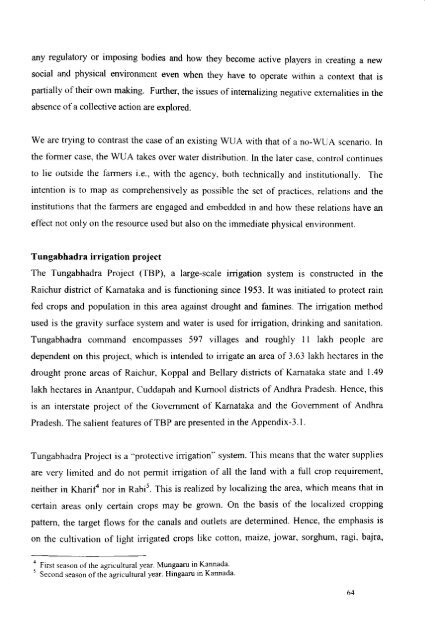Water Users Association and Irrigation Management - Institute for ...
Water Users Association and Irrigation Management - Institute for ...
Water Users Association and Irrigation Management - Institute for ...
You also want an ePaper? Increase the reach of your titles
YUMPU automatically turns print PDFs into web optimized ePapers that Google loves.
any regulatory or imposing bodies <strong>and</strong> how they become active players in creating a new<br />
social <strong>and</strong> physical environment even when they have to operate within a context that is<br />
partially of their own making. Further, the issues of internalizing negative externalities in the<br />
absence of a collective action are explored.<br />
We are trying to contrast the case of an existing WUA with that ofa no-WUA scenario. In<br />
the <strong>for</strong>mer case, the WUA takes over water distribution. In the later case, control continues<br />
to lie outside the farmers i.e., with the agency, both technically <strong>and</strong> institutionally. The<br />
intention is to map as comprehensively as possible the set of practices, relations <strong>and</strong> the<br />
institutions that the farmers are engaged <strong>and</strong> embedded in <strong>and</strong> how these relations have an<br />
effect not only on the resource used but also on the immediate physical environment.<br />
Tungabhadra irrigation project<br />
The Tungabhadra Project (TBP), a large-scale irrigation system is constructed in the<br />
Raichur district of Karnataka <strong>and</strong> is functioning since 1953. It was initiated to protect rain<br />
fed crops <strong>and</strong> population in this area against drought <strong>and</strong> famines. The irrigation method<br />
used is the gravity surface system <strong>and</strong> water is used <strong>for</strong> irrigation, drinking <strong>and</strong> sanitation.<br />
Tungabhadra comm<strong>and</strong> encompasses 597 villages <strong>and</strong> roughly II lakh people are<br />
dependent on this project, which is intended to irrigate an area of 3.63 lakh hectares in the<br />
drought prone areas of Raichur, Koppal <strong>and</strong> Bellary districts of Karnataka state <strong>and</strong> 1.49<br />
lakh hectares in Anantpur, Cuddapah <strong>and</strong> Kurnool districts of Andhra Pradesh. Hence, this<br />
is an interstate project of the Government of Karnataka <strong>and</strong> the Government of Andhra<br />
Pradesh. The salient features ofTBP are presented in the Appendix-3.1.<br />
Tungabhadra Project is a "protective irrigation" system. This means that the water supplies<br />
are very limited <strong>and</strong> do not permit irrigation of all the l<strong>and</strong> with a full crop requirement,<br />
neither in Kharif 4 nor in Rabi 5 This is realized by localizing the area, which means that in<br />
certain areas only certain crops may be grown. On the basis of the localized cropping<br />
pattern, the target flows <strong>for</strong> the canals <strong>and</strong> outlets are determined. Hence, the emphasis is<br />
on the cultivation of light irrigated crops like cotton, maize, jowar, sorghum, ragi, bajra,<br />
4 First season of the agricultural year. Mungaaru in Kannada.<br />
5 Second season of the agricultural year. Hingaaru in Kannada.<br />
64
















